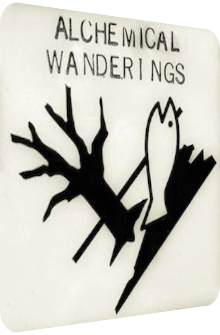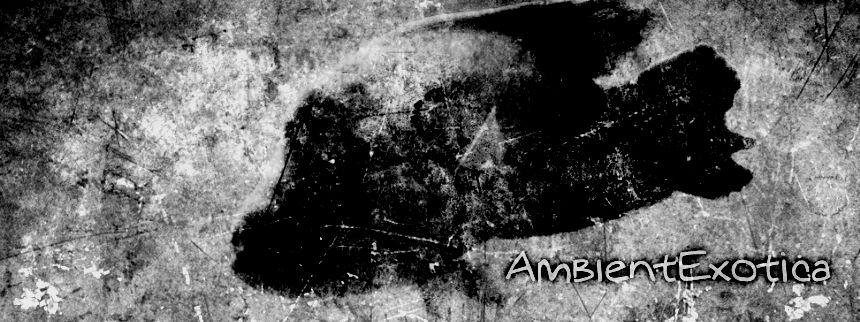
Fescal
Alchemical Wanderings
2012
An unexpected gem. When Fescal aka David Suyeong offered me the chance to review his first release of 2012, Alchemical Wanderings on the Time Released Sound label, I was more than willed to do it after the intriguing premise of a Drone record; and I did not even mention the gorgeous packaging – limited to 100 copies – which I have not experienced myself, but seen on many websites. Little did I know about the majesty and depth of the single 50+ minutes track which makes up the whole album, but is actually divided into eleven parts or subtracks. No track titles are given, and this missed opportunity caused a reviewer to take this matter in his own hands; I will provide greater details in the final paragraph. In order to respect the artist's original vision, I am going to add the respective number to each implied track. Fescal presents all known major styles of the genre, from misty whirls of enigmatic proportions over enchantingly balmy interpretations of the Pop Ambient formula to ecclesial synth hooks bathed in solemnity. Whatever the South Korean artist living in close proximity to Seoul delivers, he does it with great style and even manages to accomplish the depiction of counterintuitive dioramas: a warm, encapsulating winter landscape? Sure, it's on the album. A glaring Christmas song that is freed from all decade-lasting clichés and stereotypical mindsets? Yep, check. Glitzy bells and occasional guitar riffs are all in here, as are various ubiquitous pink noise splinters and retro vinyl crackles, but the real driving factor is the thickness of the several synth-related textures. The listener can submerge into their wideness, and never does an arrangement feel threatening or particularly dusky, though there are a few scattered instances. Brightness and coziness, however, are always outweighing the gloomier side. Moments of bliss are interwoven as well, but Alchemical Wanderings works on an aesthetically higher level by presenting calm structures which float along and are neither euphoric nor melancholic; the mood cannot be pinpointed exactly. Is this stylistic twilight the ultimate achievement of a Drone record? With these things in mind, I dive deeper into this great release.
The point of departure of Fescal’s wanderings launches with a bell-infused gong-fueled pink noise-tinted mirage. The deeply clinging chimes are the signature ingredients, but the slowly meandering and enthrallingly cozy synth aorta is at least as important, as it provides a wondrous fuzziness that wafts around the plinking opalescence; the latter is further revved up at the end as it merges with an electro-acoustic conglomeration of warped and warbled crystal shards of gelidness and the occasional glint of a Jazz-like cacophony. As the balmy luminescence of the chimes thins out, a counteracting motif appears: the second track boosts both the intimidation and pompousness of its textures, intertwining dusky drones with luckily equipollent emerald-green synth cascades and galactic brazen clangs whose reverb conflates with the hazy atmosphere. Despite its portentous title, the flow, deepness and profound aura are altogether resplendently blissful. The listener is completely encapsulated in these mellow synthscapes, and while their structure makes up the main attraction, the distant wind chimes are all the more important, for their incandescence transports an auroral ambiguity that lessens the darkness by adding scents of mystery to the scenery. While the following track #3 marries the doleful majesty of nostalgic synths in minor with the spectral sounds of braking trains in the distance and rounds these off with a second phase of an enchanting monotony of aqueously cherubic creeks, the poignantly counteracting track #4 places coruscant glass sounds in-between a grimly howling blizzard. The atmosphere is frosty and bleak, but confusingly silky. It remains curious to me why such coldness-evoking winter landscapes seem to be warmer and more inviting than Ambient compositions with darker undertones or melancholic settings. Maybe it is due to the pristine loftiness, the mood-less mood, so to speak, as track #4 really seems to be left at its own devices, not depicting any particular emotion and hence gaining its real strength and intriguing nucleus because of this notion. On track #5 the listener is surrounded by wadded synthetic clouds which waft along in a cautious manner. There is one particularly surprising element in there that has not been featured heretofore: an electric guitar. Its gently slapped strings echo through the fog which is itself replaced by a simmering stream that evokes the sound of falling rain. Fans of Chihei Hatakeyama, Minit or Ben Frost will rejoice.
It depends on the following track #6 to interweave a magnanimous dose of eeriness into the album for the first time, and even though the second track accomplished the same, number 6 doubles the effect with the help of a dissonant polyphony and its blatantly monotonous Drone structure. Containing the feelings of murkiness and solemnity, it is the latter which wins the prerogative of interpretation, as it is inherited by the golden-shimmering strings which grow in luminosity ever so slightly, but never outshine the metallic machinery in its entirety. The two feelings remain closely attached to each other. Track #7, on the other hand, ventures into nostalgic Pop Ambient climes, with light blue-colored whirling veils, a carved out yet blurred melody and an astonishing depiction of calm, tranquility and quiescence. The electric guitar is resurrected, and this time it seems to be out of place, at least to my mind, as the perfect balance is definitely lessened by the piercing two notes which occur from the second half onwards. I would have wished for a guitar-less panorama, as the song would have been all the more gorgeous then, but that’s a minor quibble and does not degrade the arrangement in the slightest. Aside from that, David Suyeong rectifies my complaint with the following offering: the particularly multilayered track #8 meshes a similar aurorally cloudy dreamscape with ghostly strings or whistles in high regions while retaining its peaceful superstructure. It is closely related to track #6, but does not include the guitar and is thus all the mellower. Next is the epic centerpiece of the album. it is running more than ten minutes and is so astonishing that I have to give its gimmick away – track #9 is a stretched Drone version of the Christmas classic Silent Night. No kidding! It is as saturated as it is serene, presenting the most voluminous, effervescent and mesmerizing church organs. It is slowed down to such a level that its syrupy kitsch is all of a sudden interpolated and transcended into truly celestial realms. Make no mistake, this is a magnificent interpretation which even the biggest hater is going to love. I don’t know how much work really went into the creation of this rendition; did Fescal just slow down an ecclesial take of it and added a few crackles, or did he set up the synth work himself? Regardless of the actual workflow, Silent Night is lachrymose! The penultimate track #10 is much thinner in comparison, but that’s expected, as it remains true to the intrinsic formula of Alchemical Wanderings. It presents distantly glowing synth washes of calm in the background that could well be an epilogue to the preceding track, while the final track #11 revisits the hibernal fragility and glitziness of a snowed up landscape. There’s not even a trace of bass attached to the glacial drones, all there is are crystalline refractions and a transfiguring ethereality that both end the album on a wonderfully content note.
David Suyeong has come up with a remarkable Drone album, with each and every subtrack of the album playing an equally important role, although some songs hark back on already introduced ideas, motifs and moods, but always add something intriguing in order to keep both the variety and coherence intact, a very difficult task on many different levels. Alchemical Wanderings succeeds and is simply delicious. Deep drones are admixed to lofty ones, Pop Ambient structures are divided by piercing guitars, Christmas traditions suddenly let even the greatest critics rub their eyes in astonishment. Warm Winter whirls, cozy coruscant clouds, languorous legato loops… whatever Fescal presents turns to rapture. The omnipresent vintage crackles are an old trick and statistically used on every third Drone album, but since they are always intact, they complement the respective soundscapes and become a transparent veil, an aorta or golden thread that constitutes and fuels the value of a track. The listener might be aware that he's listening to actual music due to the permanent hisses and crackles, but seriously, these aren't noticed anymore at a certain point. If there is one major flaw – and it has been debated on other releases since the market penetration of the compact disc – it is the long 50+ minutes track; despite the honorable motive and the didactive reason of asking the listener to be patient and to not skip a certain part in favor of listening to the album in full, I would have loved to select specific tracks whenever I'm in the mood for a particular atmosphere. Fescal is known for his long meandering tracks, but here we have the clear cut case that eleven compositions are artificially glued together. I know that David Suyeong wants to take a stand, but at least he should have given them names just because humans are so dependent on naming things. This is what Richard Allen did in his review at a closer listen in order to differentiate the moods. Mind you, the flaw of untitled, non-selectable tunes does not degrade the music in the slightest way, and so it happens that Alchemical Wanderings remains one of the very strongest Drone records I have ever encountered and resides among the cream of the crop of 2012 with ease. I'm deeply impressed!
Ambient Review 141: Fescal – Alchemical Wanderings (2012). Originally published on Oct. 31, 2012 at AmbientExotica.com.
